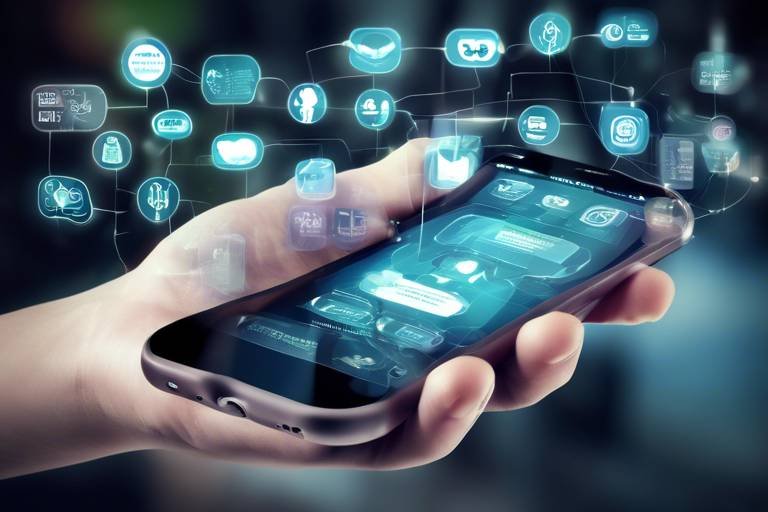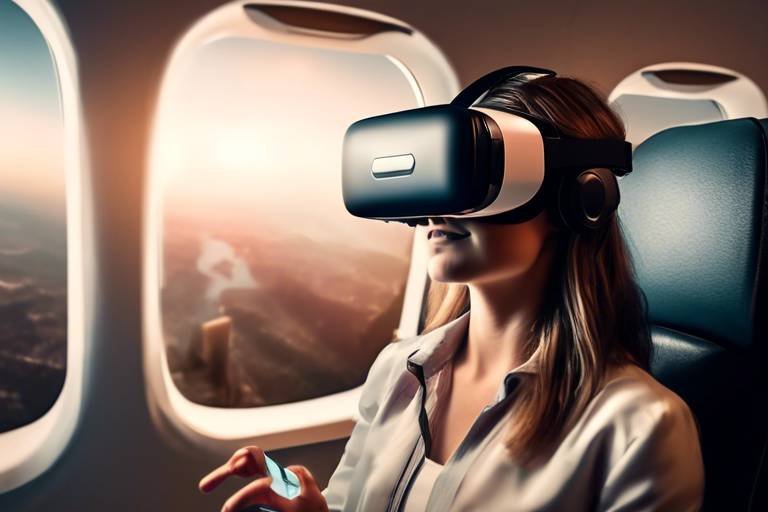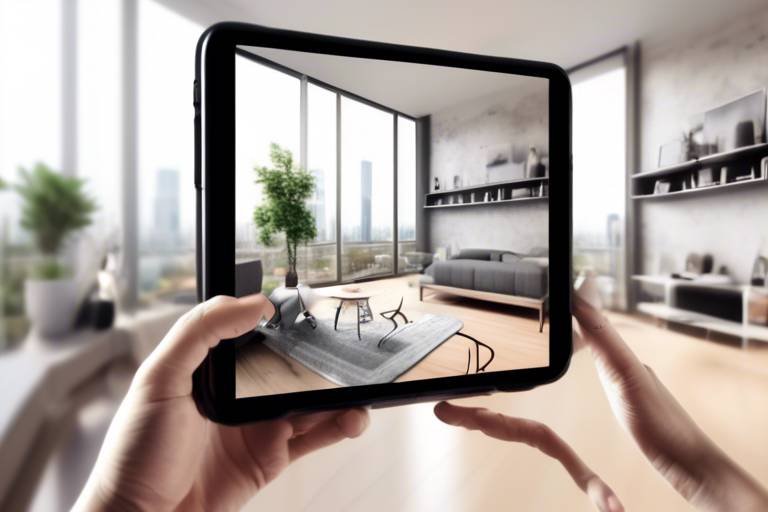Future Trends in Mental Health Technology - Apps and Wearables
The landscape of mental health technology is evolving at a breathtaking pace, with innovations that are not only transforming how we access mental health resources but also enhancing our overall well-being. Imagine a world where support for mental health is just a tap away or where your watch can alert you to rising stress levels before you even notice them. This is the future we are stepping into, one where mental health apps and wearable devices are becoming integral parts of our daily lives.
As we navigate this digital age, mental health apps are emerging as powerful tools that offer a range of services designed to cater to various needs. From mindfulness exercises to therapy sessions and mood tracking, these applications provide users with a personalized experience that can fit seamlessly into their busy lives. The convenience of having mental health support in your pocket is a game-changer, allowing individuals to seek help whenever they need it.
Moreover, the effectiveness of these apps is supported by research showing that they can lead to significant improvements in mental well-being. For instance, studies have indicated that users of mindfulness apps report lower levels of anxiety and improved mood. With a plethora of options available, ranging from guided meditation to cognitive behavioral therapy (CBT) techniques, finding the right app can feel like a treasure hunt, but the rewards are well worth the effort.
On the other hand, wearable technology is revolutionizing the way we monitor our mental health. These devices, which include smartwatches and fitness trackers, go beyond just counting steps or tracking heart rates; they are now capable of providing real-time insights into our emotional states. By collecting physiological data such as heart rate variability and sleep patterns, wearables can help users understand their mental well-being better. This proactive approach to mental health can empower individuals to make informed decisions about their care.
For instance, imagine wearing a device that alerts you when your stress levels spike, allowing you to take a moment to breathe and refocus before a situation escalates. This kind of real-time stress monitoring is not just a luxury; it’s becoming a necessity in our fast-paced world. By integrating wearables with health platforms, users can gain comprehensive insights that combine mental health data with broader health metrics, creating a holistic view of their well-being.
Looking ahead, the future of wearable technology promises even more exciting innovations. Features like AI-driven mood prediction and personalized intervention suggestions could soon be at our fingertips. These advancements will not only enhance user experience but also improve the effectiveness of mental health monitoring, making it easier than ever to stay on top of our mental health.
Personalization is becoming a key player in mental health technology. Apps and wearables are increasingly able to tailor their offerings based on individual user data and preferences. This means that the support you receive can be as unique as you are, addressing your specific challenges and goals. Whether it’s a meditation reminder tailored to your stress patterns or a mood tracker that evolves with your emotional landscape, the future is all about you.
As we embrace these technological advancements, it’s crucial to consider the implications of teletherapy and virtual support. Teletherapy has surged in popularity, offering a convenient way to access mental health professionals from the comfort of your home. While this convenience is a significant advantage, it also presents challenges, such as ensuring that all individuals have access to reliable internet and the necessary technology.
Accessibility and inclusivity in mental health technology are vital. Efforts are underway to make apps and wearables available to diverse populations, including those with disabilities. This means designing user-friendly interfaces and ensuring that resources are available in various languages and formats. The goal is to create a mental health landscape where everyone can find the support they need, regardless of their background or abilities.
However, as we dive deeper into this digital realm, ethical considerations must take center stage. Issues surrounding privacy, data security, and the responsible use of mental health applications and wearables cannot be overlooked. Users need to feel safe knowing that their data is protected and that their mental health information is handled with the utmost care. The responsibility lies with developers and providers to prioritize these ethical standards.
In conclusion, the future of mental health technology is bright, filled with potential for innovation and improvement. As we continue to explore the capabilities of apps and wearables, we must also remain vigilant about accessibility and ethical considerations. The journey towards better mental health support is not just about technology; it’s about enhancing lives, fostering connections, and ensuring that everyone has the opportunity to thrive.
- What are mental health apps? - Mental health apps are digital tools designed to support mental well-being through various features like mindfulness exercises, therapy sessions, and mood tracking.
- How do wearables monitor mental health? - Wearables track physiological data, such as heart rate and sleep patterns, to provide insights into an individual’s mental state, helping them manage stress and anxiety.
- Are mental health apps effective? - Yes, research suggests that many mental health apps can lead to significant improvements in users' mental well-being.
- What is teletherapy? - Teletherapy is a form of therapy conducted over the internet, allowing individuals to access mental health support remotely.
- How can I ensure my data is safe when using mental health technology? - Always choose reputable apps and wearables that prioritize data security and privacy, and review their privacy policies before use.

The Rise of Mental Health Apps
The world of mental health is undergoing a significant transformation, and at the forefront of this evolution are mental health apps. These digital tools have surged in popularity, providing users with a variety of resources at their fingertips. Imagine having a therapist, a mindfulness coach, and a mood tracker all available on your smartphone! With just a few taps, individuals can access therapeutic exercises, guided meditations, and daily mood check-ins that cater to their unique mental health needs. The accessibility of these apps makes them a game changer in the field of mental wellness.
One of the most appealing aspects of mental health apps is their ability to offer personalized experiences. Many of these applications utilize algorithms to adapt to user behavior and preferences, ensuring that the content is relevant and engaging. For instance, if you consistently log feelings of anxiety, the app might suggest specific mindfulness exercises or cognitive behavioral therapy (CBT) techniques tailored to help alleviate those feelings. This level of customization is crucial because mental health is not a one-size-fits-all scenario; what works for one person may not work for another.
Moreover, the effectiveness of mental health apps has been supported by various studies. Research indicates that users who engage with these tools regularly report improved mood and decreased levels of anxiety. The ease of tracking progress through features like mood journals or symptom checkers empowers users to take charge of their mental health journey. In fact, a recent study highlighted that over 70% of participants found that using mental health apps positively impacted their emotional well-being.
However, it's essential to acknowledge that not all mental health apps are created equal. The market is flooded with options, ranging from simple mood trackers to comprehensive therapy apps. To make informed choices, users should look for apps that are evidence-based and developed by qualified professionals. A good practice is to check for reviews, ratings, and the credentials of the app developers. Here’s a quick overview of some popular categories of mental health apps:
| App Type | Features |
|---|---|
| Mindfulness Apps | Guided meditations, breathing exercises, and relaxation techniques. |
| Therapy Apps | Access to licensed therapists, CBT tools, and journaling. |
| Mood Tracking Apps | Daily mood logs, symptom tracking, and personalized feedback. |
As we look to the future, the potential for mental health apps is boundless. Innovations such as artificial intelligence and machine learning are paving the way for more advanced features, such as real-time mood analysis and predictive analytics that can foresee mental health challenges before they escalate. The integration of community support features, where users can connect with others facing similar challenges, is another exciting development on the horizon.
In conclusion, the rise of mental health apps marks a significant step towards making mental health resources more accessible and personalized. As technology continues to advance, these applications will undoubtedly play a crucial role in shaping the future of mental wellness. So, if you haven't already, why not explore the world of mental health apps? You might just find the support you need right in your pocket!

Wearable Technology for Mental Health
Wearable technology is rapidly transforming the landscape of mental health care, offering innovative solutions that empower individuals to take charge of their mental well-being. These devices, ranging from smartwatches to specialized bands, are designed not just for fitness tracking but also for monitoring mental health indicators. Imagine wearing a device that not only tracks your steps but also keeps an eye on your stress levels, sleep patterns, and even your mood. This integration of mental health monitoring into everyday life allows for a more proactive approach to mental wellness.
One of the most significant advantages of wearable technology is its ability to track physiological data that correlates with mental health conditions. For instance, heart rate variability (HRV) has been linked to stress and anxiety levels. By continuously monitoring these metrics, wearables can provide real-time feedback, enabling users to recognize when they are becoming overwhelmed or stressed. This immediate awareness can prompt timely interventions, such as practicing mindfulness or engaging in breathing exercises, which can significantly reduce stress levels.
Furthermore, the data collected by these devices can be incredibly insightful. Many wearables come equipped with apps that analyze the user's data over time, offering personalized recommendations based on patterns observed. For example, if a user consistently experiences elevated heart rates during specific activities or times of day, the app can suggest strategies to mitigate stress during those periods. This level of personalization is crucial, as it allows users to develop a better understanding of their mental health triggers and responses.
Real-time stress monitoring is one of the standout features of modern wearables. These devices utilize sensors to detect changes in the body that indicate stress, such as increased heart rate or variations in skin conductance. When stress is detected, the wearable can alert the user through vibrations or notifications, prompting them to take a moment to relax or engage in a calming activity. This proactive approach can help prevent stress from escalating into more severe anxiety or panic attacks.
Integrating wearables with broader health platforms is another exciting development in mental health technology. When users sync their wearable devices with health apps, they can gain comprehensive insights into their overall well-being. For example, a user might track their sleep quality alongside their mood and stress levels, allowing for a holistic view of how different factors influence their mental health. This integration not only enhances the user experience but also provides valuable data for healthcare professionals, enabling more informed treatment plans.
The future of wearable technology in mental health is brimming with potential. Upcoming innovations promise to enhance user experience and effectiveness significantly. For instance, advancements in artificial intelligence could lead to wearables that not only track data but also provide real-time coaching based on the user's mental state. Imagine a device that suggests a guided meditation session when it detects rising stress levels or recommends a walk when it notes a dip in mood. These innovations could make mental health management more intuitive and accessible than ever before.
As we look forward to these advancements, it’s essential to consider how they can be integrated into daily life. The goal is to make mental health support as seamless and unobtrusive as possible, allowing individuals to focus on their well-being without feeling overwhelmed by technology. With the right approach, wearable technology could become an indispensable tool in the journey toward better mental health.
Q1: How can wearables help with mental health?
Wearables can track physiological indicators like heart rate and sleep patterns, providing insights into stress and mood changes. This data helps users identify triggers and manage their mental health proactively.
Q2: Are wearables effective for everyone?
While many people find wearables beneficial, effectiveness can vary based on individual preferences and mental health needs. It's essential to choose a device and app that aligns with personal goals and lifestyle.
Q3: Can wearables replace traditional therapy?
Wearables are not a substitute for professional therapy but can complement it by providing valuable data and insights. They can enhance self-awareness and support therapeutic processes.
Q4: What privacy measures should I consider with wearables?
Always review the privacy policies of wearable devices and apps. Look for features that allow you to control data sharing and ensure that your information is stored securely.

Real-Time Stress Monitoring
Imagine a world where you can literally feel your stress levels dropping as you take a deep breath. Sounds incredible, right? Well, with the advent of through wearable technology, this dream is becoming a reality for many. These innovative devices track various physiological signals, such as heart rate variability, skin conductance, and even breathing patterns, to provide users with immediate feedback on their stress levels. It's like having a personal coach on your wrist, guiding you through the tumultuous waters of daily life.
But how does it work? When you wear one of these devices, it continuously collects data and analyzes it to identify patterns that indicate stress. For example, if your heart rate spikes during a stressful meeting, the device can alert you in real time, prompting you to take a break or practice a quick mindfulness exercise. This immediate feedback allows for proactive management of stress, rather than reactive measures that may come too late.
Moreover, these wearables can offer personalized insights based on your unique stress triggers. Some users might find that their stress levels rise significantly during specific activities, like public speaking or tight deadlines. By recognizing these patterns, you can develop strategies to mitigate stress before it escalates. This level of awareness is not just empowering; it can also lead to better mental health outcomes over time.
Furthermore, the integration of real-time stress monitoring with mobile apps enhances the experience even more. Users can track their stress levels alongside other mental health metrics, creating a comprehensive picture of their well-being. For instance, you might notice that your stress peaks on Mondays but drops significantly on weekends. Such insights can help you make informed decisions about your schedule and lifestyle, ultimately leading to a more balanced life.
In summary, real-time stress monitoring through wearables is a game-changer in the realm of mental health technology. It provides individuals with the tools they need to understand and manage their stress effectively. As technology continues to evolve, we can only expect these devices to become more sophisticated, offering even deeper insights and support for our mental well-being.
- What types of wearables are best for stress monitoring? Popular options include smartwatches, fitness trackers, and specialized stress-monitoring devices that focus solely on physiological indicators.
- How accurate are these stress monitoring devices? While they provide valuable insights, it's essential to remember that they are not a replacement for professional medical advice. Their accuracy can vary based on the technology used and individual differences.
- Can I use these devices for long-term stress management? Absolutely! Many users find that tracking their stress over time helps them identify patterns and triggers, allowing for more effective coping strategies.

Integration with Health Platforms
In today's fast-paced world, the integration of mental health wearables with broader health platforms is nothing short of revolutionary. Imagine having a single hub where all your health data converges—your heart rate, sleep patterns, and even your mental health metrics. This is not just a dream; it’s becoming a reality. By syncing data from various sources, users can gain a comprehensive view of their overall health, which includes mental well-being. This holistic approach allows for a deeper understanding of how physical health impacts mental health and vice versa.
One of the significant advantages of this integration is the ability to track trends over time. For instance, if a user notices an uptick in anxiety levels coinciding with poor sleep quality, they can take proactive measures. This is where the synergy of wearables and health platforms shines. Users can receive tailored recommendations based on their data, such as mindfulness exercises when stress levels are high or sleep hygiene tips when rest is lacking. This personalized feedback loop is crucial for effective mental health management.
Moreover, integrating mental health data with general health metrics can facilitate better communication between patients and healthcare providers. When a therapist or doctor has access to a patient’s comprehensive health profile, they can make more informed decisions about treatment plans. This leads to a more personalized approach to therapy, where interventions can be adjusted based on real-time data.
However, while the benefits are substantial, there are also challenges to consider. Data security and privacy are paramount, especially when dealing with sensitive mental health information. Users must be assured that their data is protected and that they have control over who accesses it. This is where ethical considerations come into play, as developers and health platforms must prioritize user consent and transparency in data usage.
In summary, the integration of mental health wearables with health platforms is paving the way for a more interconnected and insightful approach to mental well-being. By leveraging technology to create a cohesive health narrative, users can take charge of their mental health like never before. As we look to the future, the potential for enhanced user experience and improved mental health outcomes is indeed exciting.

Future Innovations in Wearables
The future of wearable technology in the realm of mental health is nothing short of exhilarating. Imagine a world where your wristband not only tracks your heart rate but also assesses your emotional state by analyzing your physiological responses. These innovations are on the horizon, and they promise to revolutionize how we understand and manage our mental well-being. As technology advances, we can expect wearables to integrate more sophisticated sensors, machine learning algorithms, and even artificial intelligence to provide real-time insights into our mental health.
One exciting development is the incorporation of biometric sensors that can monitor stress levels through various physiological markers such as skin temperature, galvanic skin response, and heart rate variability. This data can be invaluable, allowing users to receive immediate feedback about their mental state. For instance, if your device detects an increase in stress levels, it could suggest a breathing exercise or a short mindfulness session, effectively acting as a personal mental health coach right on your wrist.
Moreover, the future of wearables is leaning towards personalization. Imagine wearables that learn from your habits and preferences, tailoring interventions specifically for you. This could mean adjusting meditation reminders based on your daily stress patterns or recommending specific therapeutic exercises when you're feeling down. The more these devices learn about you, the more effective they can become in providing support.
Additionally, we are likely to see improved connectivity between wearables and other health platforms. This integration will allow for a more comprehensive view of an individual's health by combining mental health data with physical health metrics. For example, a user could see how their sleep patterns impact their mood or how physical activity correlates with stress levels. This holistic approach can empower users to make informed decisions about their health and well-being.
As we look towards the future, the potential for wearables to incorporate augmented reality (AR) and virtual reality (VR) features is also intriguing. Imagine a scenario where you could use AR glasses to visualize your stress levels in real-time or engage in immersive environments designed to promote relaxation and mindfulness. These technologies could take mental health interventions to a whole new level, making them more engaging and effective.
In conclusion, the innovations in wearable technology for mental health are not just about tracking data; they are about creating a personalized, interactive experience that empowers users to take control of their mental well-being. As these technologies evolve, they hold the promise of making mental health resources more accessible and effective for everyone.
- What are mental health wearables?
Mental health wearables are devices that monitor physiological data to provide insights into an individual's mental well-being. They can track metrics like heart rate, sleep patterns, and stress levels.
- How do mental health apps work?
Mental health apps offer tools for mindfulness, therapy, and mood tracking, helping users manage their mental health through guided exercises and self-assessment.
- Are wearables effective for mental health?
Yes, wearables can be effective by providing real-time data and personalized feedback, enabling users to respond proactively to their mental health needs.
- What innovations can we expect in the future?
Future innovations may include advanced biometric sensors, AI-driven personalization, improved connectivity with health platforms, and the integration of AR and VR for immersive mental health experiences.

Personalized Mental Health Solutions
In the ever-evolving landscape of mental health technology, personalization stands out as a crucial element that can significantly enhance the effectiveness of mental health interventions. Imagine walking into a coffee shop where the barista already knows your favorite drink, your preferred size, and even how much sugar you like. That's the kind of tailored experience we are striving for in mental health solutions. Personalized mental health apps and wearables are designed to adapt to individual needs, preferences, and behaviors, making mental health support not just a one-size-fits-all approach but a uniquely crafted journey.
These technologies leverage data analytics and artificial intelligence to provide customized recommendations and interventions. For example, a mental health app might analyze your mood patterns over time, allowing it to suggest specific mindfulness exercises or coping strategies that have been effective for you in the past. This tailored approach not only increases engagement but also improves outcomes, as users are more likely to stick with interventions that resonate with them personally.
Moreover, personalization doesn't just stop at mood tracking. Many apps integrate machine learning algorithms that learn from user interactions. As you continue to use the app, it becomes smarter and more attuned to your emotional states. For instance, if you consistently log feelings of anxiety during certain times of the day, the app might proactively send you reminders or resources to help you manage those feelings before they escalate.
Wearable devices also play a pivotal role in personalizing mental health solutions. By continuously monitoring physiological data—like heart rate variability, sleep patterns, and even skin temperature—these devices can provide real-time feedback. This data can be used to create a personalized mental health profile that highlights your stress triggers and emotional responses. For example, if your wearable detects an increase in heart rate during a stressful meeting, it can suggest breathing exercises or mindfulness techniques right when you need them the most.
In addition to real-time feedback, many wearables now offer customizable features that allow users to set their own goals and track their progress. Whether it’s aiming for a certain number of meditation minutes per day or monitoring sleep quality, these features empower users to take control of their mental health journey. The ability to adjust settings based on personal goals fosters a sense of ownership and commitment to one's mental well-being.
However, it’s essential to remember that while personalization in mental health technology is groundbreaking, it must be approached with caution. As we harness the power of data, we must also prioritize privacy and security. Users should be informed about how their data is being used and have control over their information. The goal is to build trust and ensure that these personalized solutions are not only effective but also ethical.
In conclusion, personalized mental health solutions are transforming the way we approach mental well-being. By leveraging data and technology, these tools provide tailored experiences that resonate with individual users, ultimately leading to better engagement and outcomes. As we move forward, the challenge will be to balance innovation with ethical considerations, ensuring that everyone can benefit from these advancements in mental health technology.
- What are personalized mental health solutions? Personalized mental health solutions are tailored interventions and tools that adapt to individual user data and preferences, enhancing the effectiveness of mental health support.
- How do mental health apps personalize user experiences? Mental health apps use data analytics and machine learning to provide customized recommendations based on user behavior, mood patterns, and interactions with the app.
- Can wearables really help with mental health? Yes, wearables monitor physiological data and provide real-time feedback, helping users understand their stress triggers and emotional responses, leading to timely interventions.
- Is my data safe with mental health apps and wearables? While many companies prioritize user privacy and data security, it's essential to review the privacy policies and data usage practices of any app or device you use.

Teletherapy and Virtual Support
In recent years, teletherapy has emerged as a game-changer in the mental health landscape, offering a convenient and accessible way for individuals to seek support. Imagine being able to connect with a therapist from the comfort of your own home, without the need to navigate the stress of commuting or waiting in a crowded office. This shift towards virtual support has not only made therapy more accessible but has also opened doors for those who may have previously felt hesitant to seek help. The beauty of teletherapy lies in its flexibility; you can schedule sessions that fit your lifestyle and even choose the medium that works best for you—be it video calls, phone calls, or even messaging platforms.
However, while the benefits of teletherapy are numerous, it also comes with its own set of challenges. For instance, some individuals may struggle with the technology aspect, feeling overwhelmed by the various platforms available. Others may miss the face-to-face interaction that traditional therapy provides, which can sometimes be crucial for building a therapeutic relationship. Despite these challenges, the advantages often outweigh the drawbacks, especially when considering the growing acceptance of mental health issues and the need for immediate support.
One of the most significant advantages of teletherapy is its accessibility. It breaks down geographical barriers, allowing individuals in remote areas to connect with qualified professionals. This is particularly important for those who may not have access to mental health resources in their local communities. Furthermore, teletherapy can cater to a wide range of populations, including students, working professionals, and even those with disabilities who may find it challenging to attend in-person sessions.
Moreover, teletherapy can be incredibly beneficial during times of crisis, such as during the COVID-19 pandemic. When in-person visits became risky, teletherapy provided a lifeline for many, ensuring that mental health support remained available. The ability to access therapy from home not only made it safer but also offered a sense of normalcy during uncertain times. As we move forward, the integration of technology in mental health care is likely to continue evolving, making virtual support an essential component of comprehensive mental health strategies.
As we explore the future of teletherapy, it’s essential to consider the various platforms available. Some popular platforms include:
- BetterHelp: Offers a range of therapists and flexible communication options.
- Talkspace: Focuses on text-based therapy, allowing users to communicate with their therapists at their convenience.
- Amwell: Provides video therapy sessions with licensed professionals.
As technology continues to advance, we can expect even more innovations in teletherapy. Features like AI-driven chatbots for initial assessments and virtual reality environments for immersive therapy experiences are on the horizon. These advancements promise to enhance user experience and make therapy more engaging and effective.
In conclusion, teletherapy and virtual support represent a significant leap forward in mental health care. By making therapy more accessible and flexible, we are paving the way for a future where mental health support is just a click away. As we embrace these changes, it's crucial to remain aware of the challenges and work towards solutions that ensure everyone can benefit from these advancements.
- What is teletherapy? Teletherapy is a form of therapy conducted over the internet, allowing individuals to connect with mental health professionals remotely.
- Is teletherapy as effective as in-person therapy? Research suggests that teletherapy can be just as effective as traditional face-to-face therapy for many individuals.
- What platforms can I use for teletherapy? Some popular platforms include BetterHelp, Talkspace, and Amwell.
- Can I use teletherapy for urgent mental health issues? Yes, many platforms offer immediate support for urgent situations, but it's essential to check the availability of services in your area.

Accessibility and Inclusivity
In today's digital age, accessibility and inclusivity in mental health technology are not just buzzwords; they are essential components that can make a significant difference in the lives of many individuals. Imagine a world where everyone, regardless of their background or abilities, has equal access to mental health resources. This vision is becoming a reality as developers and mental health professionals work together to create solutions that cater to diverse populations. The importance of accessibility cannot be overstated—after all, mental health challenges affect people from all walks of life, and technology should reflect that diversity.
One of the key steps towards achieving inclusivity in mental health apps and wearables is to ensure that they are designed with various user needs in mind. For instance, developers are increasingly incorporating features that cater to individuals with disabilities. This includes voice-activated controls for those with mobility impairments, as well as visual aids and screen readers for users with visual impairments. Such adaptations not only enhance usability but also empower users to take control of their mental health journey.
Moreover, it's crucial to consider the cultural nuances that can influence mental health perceptions and treatment. Mental health technology should be adaptable to different cultural contexts, offering resources that resonate with diverse populations. This could mean providing content in multiple languages or featuring culturally relevant coping strategies and support systems. By acknowledging these differences, mental health technology becomes more relatable and effective for users from various backgrounds.
Another significant aspect of accessibility is the affordability of mental health technology. Many individuals face financial barriers that prevent them from accessing traditional therapy or mental health services. This is where apps and wearables can play a transformative role. By offering free or low-cost options, these technologies can bridge the gap for those who might otherwise go without the support they need. It's about making mental health care not just a privilege but a right for everyone.
To further illustrate the current state of accessibility in mental health technology, consider the following table that highlights some key features that enhance inclusivity:
| Feature | Description | Benefit |
|---|---|---|
| Multi-Language Support | Apps that offer content in various languages. | Increases reach and usability for non-native speakers. |
| Adaptive Interfaces | Customizable layouts for users with different abilities. | Enhances user experience and accessibility. |
| Affordability Options | Free or low-cost access to mental health resources. | Reduces financial barriers for users. |
| Cultural Relevance | Content that reflects diverse cultural perspectives. | Improves engagement and effectiveness of interventions. |
As we look to the future, the challenge remains: how do we ensure that mental health technology continues to evolve in a way that prioritizes accessibility and inclusivity? The answer lies in collaboration—between developers, mental health professionals, and the communities they serve. By listening to user feedback and staying attuned to the unique needs of various populations, we can create mental health solutions that are not only effective but also equitable.
In conclusion, the journey towards accessibility and inclusivity in mental health technology is ongoing, but the strides being made are promising. With a commitment to understanding and addressing the diverse needs of users, we can pave the way for a future where mental health resources are accessible to all.
- What are some examples of accessible mental health apps? There are numerous apps designed with accessibility in mind, such as Headspace, which offers features for different abilities, and Moodfit, which provides customizable options.
- How can I ensure a mental health app is inclusive? Look for features like multi-language support, adaptive interfaces, and culturally relevant content that resonates with diverse populations.
- Are there free mental health resources available? Yes, many apps and platforms offer free access to mental health resources, including therapy sessions and self-help tools.

Ethical Considerations in Mental Health Tech
As mental health technology continues to evolve, the ethical considerations surrounding its use become increasingly important. With the rise of apps and wearables designed to monitor and support mental well-being, we must ask ourselves: Are we prioritizing user privacy and data security? The answer is crucial, as these technologies often collect sensitive personal information that, if mishandled, could lead to significant consequences for users.
One of the primary ethical concerns is data privacy. Users must feel confident that their mental health data is secure and used solely for the intended purpose. Imagine sharing your innermost thoughts and feelings through an app, only to find out that this data is being sold to third parties without your consent. To prevent such scenarios, developers need to implement robust security measures and transparent data policies. This includes informing users about how their data will be used, stored, and shared.
Moreover, there is a pressing need for informed consent. Users should have a clear understanding of what they are agreeing to when they sign up for a mental health app or wearable device. This means providing straightforward explanations of the technology's capabilities, limitations, and potential risks. For instance, if an app claims to help manage anxiety but does not have evidence-based methods backing its approach, users deserve to know this upfront.
Another significant concern is the potential for bias in algorithms. Mental health technologies often rely on algorithms to provide personalized recommendations or assessments. However, if these algorithms are trained on biased data sets, they may unintentionally perpetuate stereotypes or fail to serve underrepresented populations effectively. It is essential for developers to actively work towards creating inclusive algorithms that consider diverse user backgrounds and experiences.
Furthermore, the role of human oversight cannot be overlooked. While technology can offer valuable insights, it should not replace the human touch in mental health care. There should always be a pathway for users to connect with qualified professionals, especially in cases where the technology identifies concerning patterns or behaviors. This blend of technology and human support can create a more comprehensive mental health care system.
Lastly, we must also consider the challenge of regulation. As mental health tech expands, so does the need for clear regulations to ensure safety and efficacy. Governments and regulatory bodies must step in to establish guidelines that protect users while fostering innovation. This balance is delicate but necessary to ensure that mental health technologies serve their intended purpose without compromising ethical standards.
In conclusion, the ethical considerations in mental health technology are multi-faceted and require ongoing dialogue among developers, users, and regulatory bodies. By prioritizing privacy, informed consent, inclusivity, human oversight, and robust regulations, we can harness the power of technology to enhance mental well-being while safeguarding the rights and dignity of individuals.
- What are the main ethical concerns regarding mental health technology? The primary concerns include data privacy, informed consent, algorithmic bias, the need for human oversight, and regulatory challenges.
- How can users protect their data when using mental health apps? Users should read privacy policies, use apps with strong security measures, and be cautious about sharing personal information.
- Why is human oversight important in mental health technology? Human oversight ensures that technology complements professional care, especially in critical situations where intervention may be necessary.
- What role do regulations play in mental health tech? Regulations help establish guidelines that protect users while encouraging innovation, ensuring that mental health technologies are safe and effective.
Frequently Asked Questions
- What are mental health apps and how do they work?
Mental health apps are digital tools designed to support users in managing their mental well-being. They often include features like guided meditations, mood tracking, and cognitive-behavioral therapy exercises. By using these apps, individuals can gain insights into their mental health patterns and access resources that promote self-care.
- Can wearable devices really help with mental health?
Absolutely! Wearable devices track physiological indicators, such as heart rate and sleep patterns, which can provide valuable insights into a person's mental state. By monitoring these metrics in real-time, users can identify stress triggers and take proactive steps to manage their mental health effectively.
- What is real-time stress monitoring and why is it important?
Real-time stress monitoring involves using wearable technology to continuously track stress levels. This capability is crucial because it allows individuals to recognize when they are becoming stressed and take immediate action to mitigate those feelings, such as practicing mindfulness or deep-breathing exercises.
- How do mental health apps and wearables personalize user experiences?
Personalization in mental health technology is achieved by analyzing user data, preferences, and behaviors. Apps and wearables can tailor interventions and recommendations based on this information, ensuring that users receive support that is relevant and effective for their unique situations.
- What are the benefits of teletherapy?
Teletherapy offers numerous advantages, including convenience, accessibility, and the ability to connect with mental health professionals from the comfort of home. It breaks down geographical barriers, allowing individuals to seek help without the constraints of traditional in-person therapy.
- How do we ensure accessibility and inclusivity in mental health technology?
Ensuring accessibility and inclusivity involves designing apps and wearables that cater to diverse populations, including those with disabilities. This can include features like voice commands, visual aids, and customizable interfaces that make it easier for everyone to use these technologies.
- What ethical considerations should be taken into account with mental health tech?
As mental health technology evolves, it’s essential to consider privacy and data security. Users must be informed about how their data is used and protected, and companies should prioritize responsible practices to maintain trust and safeguard sensitive information.



















